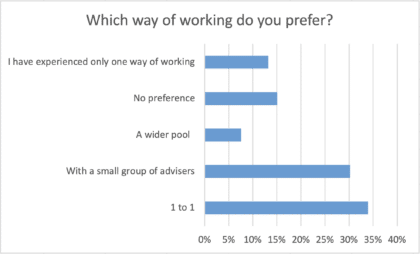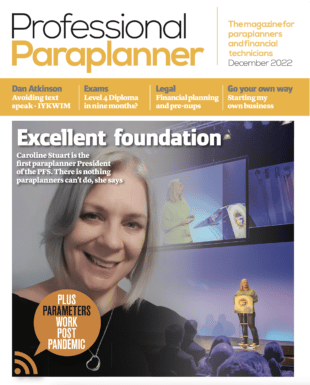In our most recent parameters survey, we asked you for your views on the perfect adviser to paraplanner ratio, if there is one. Fiona Bond reports on the results.
The vast majority of paraplanners tend to support a smaller number of advisers, according to the Professional Paraplanner parameters survey.
More than half (53%) said they provide support to less than 5 advisers, with 28% providing one-to-one support. In contrast, just 4% of paraplanners work with between 6 – 10 advisers and 15% provide services for a larger pool of advisers.
When asked which style of working they prefer, more than a third (34%) cited a one-to-one approach, while 30% said they also preferred working with a small group of advisers. Just 8% expressed a preference for a wider pool and 15% said they had no preference.
Among those who preferred working with a smaller number of advisers, one said: “Currently, all paraplanners work with all planners but it could be better having set planers to work with as we would get to know the clients, as well as the planners’ way of working and how to interpret their advice.”
Reece Edwards, technical and research manager at Hampshire Hill, commented: “I think that having a support team that looks after a small number of advisers works. The advantage of working with a small number of advisers is that you get to learn their styles and client bank.
“If you have too many advisers per paraplanner it could get complex and overwhelming but I do think that it would depend on the firm’s set up and the support given to the paraplanner. Paraplanners should, in my opinion, try and organise themselves accordingly and if it is too much, they need to speak to their line manager to discuss the support they may need.”
However, the survey also shone a spotlight on the pitfalls of working for one or just a few advisers, including a lack of structure and changes to workflow according to the adviser’s wants and needs.
One respondent responsible for managing a team of paraplanners said tracking quality can become more challenging.
“Each paraplanner works with three advisers. It works ok but having managed a centralised team previously, I find it more difficult to monitor workflow, quality and pre-checking files,” they commented.
Working with a small number of advisers also raises the issue of how to split time between their individual workloads as the work required for each of their clients differs.
“I work for two advisers and it can be difficult to prioritise work when they both have urgent cases. They are both patient and understanding people but I could imagine it would cause problems with more demanding advisers,” one said.
For those supporting a larger number of advisers, the survey also identified a number of advantages and disadvantages.
Benefits include the opportunity to enjoy a more varied workload and the chance for greater personal development.
Derek Anderson, paraplanner at Investec Wealth and Management, currently works with five advisers on a pooled basis and is part of a team of five paraplanners.
He said: “I think I prefer the pooled team of paraplanners for a couple of reasons. You get a more varied type of work case which helps broaden knowledge and means every day can be different. This is key for personal development and keeping knowledge up-to-date and relevant. It also helps with holiday periods and managing larger teams, so works still gets completed and individuals are not swamped after returning.”
Anderson said he sees no risk in working for many advisers, instead pointing out that it provides an insight into what good practices are which can then be shared among others.
“I think there is more risk working one-to-one as it may not be apparent that bad habits are being constantly used,” he adds.
However, working with several advisers means paraplanners can face a number of challenging cases and organisation is key.
One paraplanner said that they implemented a ‘first come, first serve’ method so that cases were done in the order that they had been asked in.
“If I wasn’t given enough notice, it wasn’t getting done to their timescales and I was able to implement a 2-week request system. This also prevented last minute meetings being booked in and provided a clear structure for all,” they added.
Those who worked for more advisers warned that a heavy workload can also have an impact on job satisfaction.
One paraplanner added: “I have previously worked within a larger paraplanning remit when I was paraplanner for and coached over 20 advisers and at times had almost 100 cases on the go. I juggled it very well but it’s the sort of environment that gives very little praise and only occasional job satisfaction.”

Adviser support ratio

Adviser support ratio preference





























